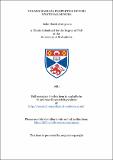Files in this item
The mechanical properties of fish myotomal muscle
Item metadata
| dc.contributor.advisor | Johnston, Ian A. | |
| dc.contributor.author | Altringham, John Derek | |
| dc.coverage.spatial | 163 p. | en_US |
| dc.date.accessioned | 2018-07-06T11:53:47Z | |
| dc.date.available | 2018-07-06T11:53:47Z | |
| dc.date.issued | 1981 | |
| dc.identifier.uri | https://hdl.handle.net/10023/15053 | |
| dc.description.abstract | CHAPTER 1 A brief introduction is given to the structure, biochemistry and electrophysiological and mechanical properties of fish muscle. CHAPTER 2 1. The neuromuscular end plates and preterminal axons of cod, Gadus morhua, fast myotomal muscle were stained for cholinesterase activity. 2. The number of end plates per fibre on superficial fast fibres (17.88 ± 2.13, mean ± 1 S.D.) was significantly higher than that of deep fast fibres (14.79 ± 2.48, P<< 0.001). A small degree of multi-terminal innervation was noted. The end plates showed a great variety in structure and size. 3. Fast muscle contains fibres with a wide range of diameters (20-240 µm). However, no correlation was found between the number of end plates per fibre and fibre diameter. CHAPTER 3 1. The force-velocity characteristics of threads of natural actomyosin, and purified component proteins, from dogfish fast and slow muscle, and rabbit fast skeletal and cardiac muscle have been investigated. 2. Maximum isometric tensions were around 30-70 g cm⁻². The time taken to reach full tension after activation with ATP was 2-8 min. 3. Force-velocity curves obtained could be fitted to a linear form of Hill's equation (1938). In common with intact and skinned fibre studies, points below 0.7 P₀ were found to lie on a straight line. 4. Maximum contraction velocities were around 10⁻² Ls⁻¹, 2-3 orders of magnitude lower than those of intact muscle fibres. 5. The relative velocities of the different thread types do not reflect those of the corresponding muscles, on the basis of measurements on intact fibres, and on measurements of actomyosin/myofibrillar ATPase activities. 6. It is concluded that filament formation, geometry and packing, and not differences in cross bridge cycling rates, largely determine the observed properties of actomyosin threads. CHAPTER 4 A description of the apparatus used to study the isometric and isotonic properties of skinned fibres is given, together with the methods and protocol used in Chapters 5-7. CHAPTER 5 1. The pCa-tension relationship of cod, Gadus morhua, and dogfish, Scyliorhinus canicula, fast and slow skinned fibres isolated from the myotomal muscles was investigated. 2. Maximum isometric tensions were 1.9 ± 0.12 (mean ± 1 S.E.) (fast) and 0.85 ± 0.10 (slow) for cod fibres, and 1.87 ± 0.09 (fast) and 0.84 ± 0.04 (slow) for dogfish (All values : kg cm⁻²). 3. Sigmoid pCa-tension curves were obtained for all fibre types. Values for the half maximally activating [Ca²⁺], and n, the minimum number of Ca²⁺ binding sites involved in activation, were calculated: Thus, the minimum number of Ca²⁺ binding sites in cod is two, in dogfish, four. In both fish, greater cooperativity is exhibited by the fast muscle. CHAPTER 6 1. Force-velocity curves were derived from fast and slow skinned fibres isolated from cod and dogfish myotomal muscles. 2. The extrapolated V and the constants a and b were calculated max from a linear form of Hill's equation: 3. These results are discussed with reference to previous studies of the P-V relationship in amphibian and mammalian muscle. The relationship between a/P₀ and efficiency, and its bearing on the present results is discussed.4. Velocity transients showed a small departure from linearity in all experiments, with velocity decreasing continuously during release (usually < 25% over the first 250 ms after release). This is a feature common to many previous experiments on skinned and intact fibres. The decrease in velocity during release was particularly marked in cod slow fibres. Similar results have been reported in amphibian slow muscle. CHAPTER 7 1. Contraction velocity at low loads was studied in dogfish fast fibres during maximal and submaximal activations. 2. The velocity of contraction during the second 50 ms interval after the onset of release was reduced significantly at low [Ca²⁺], The shape of the velocity transient was found to be dependent on [Ca²⁺]. The rate of decrease of velocity was greater in submaximal than in maximal activations. 3. A brief review of previous studies on the dependence of Vmax on max [Ca²⁺] is given. 4. The results are discussed in the light of recent evidence for length dependent changes in the contractile system. Possible mechanisms for a Ca²⁺ and length dependent inactivation process are considered. CHAPTER 8 The major outstanding problems are stated, and suggestions are made for further work which may give a greater insight into the molecular events underlying contraction in fish muscle. (Abstract shortened) | en_US |
| dc.language.iso | en | en_US |
| dc.publisher | University of St Andrews | |
| dc.subject.lcc | QL831.A6 | |
| dc.subject.lcsh | Muscles | en |
| dc.title | The mechanical properties of fish myotomal muscle | en_US |
| dc.type | Thesis | en_US |
| dc.contributor.sponsor | Biotechnology and Biological Sciences Research Council (BBSRC) | en_US |
| dc.type.qualificationlevel | Doctoral | en_US |
| dc.type.qualificationname | PhD Doctor of Philosophy | en_US |
| dc.publisher.institution | The University of St Andrews | en_US |
This item appears in the following Collection(s)
Items in the St Andrews Research Repository are protected by copyright, with all rights reserved, unless otherwise indicated.

